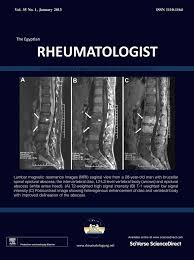Abstract Aim of the work: To investigate the possible role of serum homocysteine in the eye
involvement in Egyptian patients with Behc¸ et’s disease (BD).
Patients and methods: A case–control study was made on 27 patients with BD (17 males and 10
females with a mean age of 32.11± 7.16 years) and 19 healthy control subjects. All patients fulfilled
the criteria of the International Study Group for BD. The patients were categorized as BD with eye
involvement (n= 12), or BD without eye involvement (n= 15). Serum homocysteine and
C-reactive protein levels were studied in all patients and controls.
Results: The mean serum homocysteine concentrations were significantly higher in BD patients
than in healthy controls (15.56± 3.52 and 7.32 ±1.38 lmol/L, respectively; P <0.001). Also, the
mean serum homocysteine concentrations were significantly higher in BD patients with eye involvement
compared to those without eye involvement (18.50± 3 and 13.2 ± 1.61 lmol/L, respectively;
P < 0.001). CRP, as a marker of disease activity was significantly higher in BD patients than in
controls (14.33± 8.28 and 3.21 ± 1.72 mg/L, respectively; P < 0.001), however, no significant difference
(P = 0.213) in CRP levels was found between BD patients with or without eye involvement.
Conclusion: Homocysteine may play a role in BD patients with ocular involvement. Assessment
of homocysteine may be important in the investigation and management of patients with BD, especially
with ocular disease.


